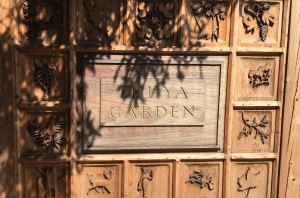Winds blew down from the plains of Canada again, bringing cooler weather to Austin. Does it feel like winter? Not really. But it’s nice to wake up to a cold house. Turning on the heat and drinking a leisurely cup of coffee in the morning are two of life’s great pleasures.
Last summer, my friend Sharon and I set off with our poodles on a pilgrimage to Northeast Harbor, an idyllic village smack dab in the middle of Acadia National Park. Many years ago we worked as chambermaids at a gray-shingled family compound right across the drive that led to Thuya Gardens. After I tidied the house for the day, I changed into shorts, tied a sweater around my waist, and headed up that drive for an afternoon of hiking. The sweater kept drizzle and deer flies at bay when I tied it, Laurence of Arabia style, around my head; it was the only thing I carried with me on the trails. I drank water straight from the streams that thundered down the rocky crevices through stands of birch and pine.
 Thuya Gardens was my first stop on the way to the Asticou Map House, a rustic enclosure containing a bench seat and framed topographical map of Acadia National Park. From there, I would hit the trails.
Thuya Gardens was my first stop on the way to the Asticou Map House, a rustic enclosure containing a bench seat and framed topographical map of Acadia National Park. From there, I would hit the trails.
I liked to walk straight through the front entrance gate of the garden — designed and hand-carved from cedar by Charles K. Savage, the man who created the garden — and out a lesser known gate at the back of the garden. The transition from Edwardian elegance to coastal wilderness never failed to thrill me. On foggy days, the herbaceous borders were shrouded with mist, the dahlias and staked delphinium beaded with moisture that bent their heads downward. There was a shrouded silence on mornings like this, only broken by the cawing of crows in the surrounding treetops.
The place hasn’t changed a bit in 30 years. There is still the shaggy backdrop of pines rustling behind the border wall, the pot-bellied urns standing sentinel, the brightly blooming flower beds. Charles Savage, a landscape architect and life-long resident of Northeast Harbor, designed the garden during his 37-year tenure as trustee of the land left by Joseph Henry Curtis, a Boston landscape architect who summered in Northeast Harbor. His house, Thuya Lodge, now houses a collection of botanical and horticultural books and is open to visitors during the summer months.
The garden’s design is a coastal Maine take on the work of two noted landscape architects, the British designer Gertrude Jekyll and Beatrix Farrand, who planned the garden at Bellefield, the estate of Franklin D. Roosevelt. Plants purchased from Reef Point, Farrand’s summer home in Bar Harbor, were some of the first specimens in Thuya Garden.
The garden features a central corridor of gentle terraces that flow upward from the Japanese reflecting pond at one end to a red roofed shelter at the other. Hardscaping in native granite helps the garden both to have formal boundaries and to transition into the surrounding landscape. The beds host a combination of cultivated European hybrids and native North American flowers.
On summer afternoons, a few die-hard garden enthusiasts make their way up the Asticou Terrace Trail from Peabody Drive, where they are able to pause at several strategically placed shelters to catch views of Northeast Harbor. The place is never crowded, though, and serenity prevails.
Thuya Lodge and Gardens is open throughout the summer. Check out their official website for more information.








